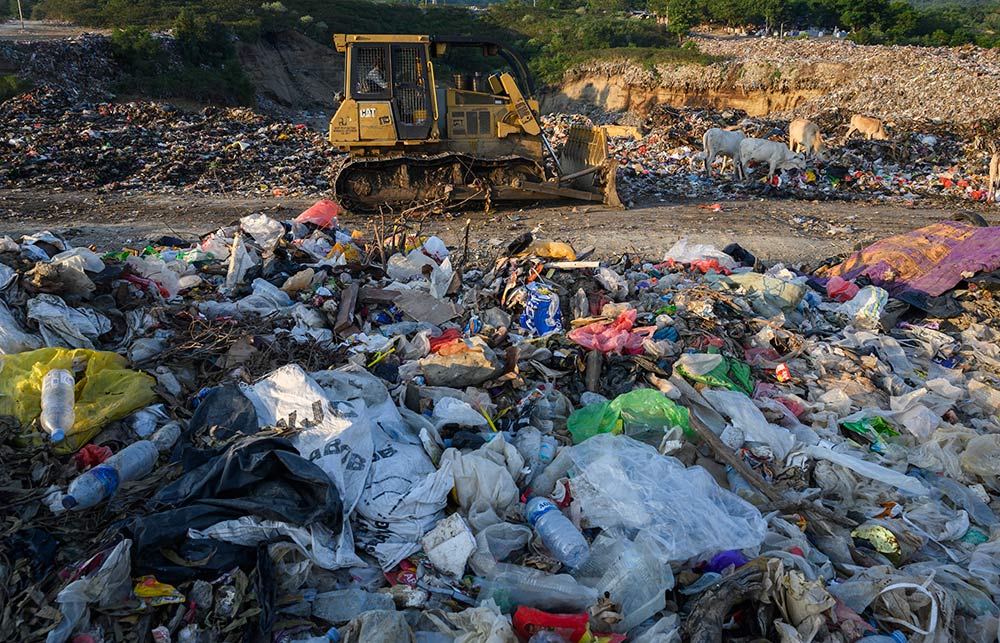
這項技術(shù)能幫助解決塑料垃圾日益增多的問題,因為它可以把塑料恢復(fù)到原始結(jié)構(gòu),。不僅如此,,它還能提供當(dāng)前無法實現(xiàn)的新方法,,改進(jìn)塑料回收過程,減少使用化石燃料生產(chǎn)新塑料的需求,。但到目前為止,,這種技術(shù)的降解過程過于緩慢,還無法用于商業(yè)用途,。
早在2016年,,科學(xué)家在日本的一家垃圾回收廠內(nèi)發(fā)現(xiàn)了吃塑料的細(xì)菌。兩年后,,英國樸茨茅斯大學(xué)(University of Portsmouth)和美國能源部(U.S. Department of Energy)國家可再生能源實驗室(National Renewable Energy Laboratory)的研究人員嘗試模擬這種細(xì)菌中的“PETase”酶,,以深入了解它的特性,結(jié)果研究人員意外合成了一種突變酶,,這種酶降解聚對苯二甲酸乙二酯(PET)塑料的效率更高,。PET塑料常被用于生產(chǎn)塑料瓶。
兩年后,,研究人員有了新的發(fā)現(xiàn),。
他們在近期發(fā)表的一篇研究報告中表示,突變PETase酶可以與從同一種吃塑料的細(xì)菌中發(fā)現(xiàn)的另外一種MHETase酶合成,。他們發(fā)現(xiàn),,這兩種酶合成后,降解塑料的速度提高了一倍,。如果精心設(shè)計兩種酶之間的連接方式,,降解速度還能提高三倍。
換言之,,這種“多種酶混合液”降解塑料的速度是最初發(fā)現(xiàn)的突變PETase酶(比正常PETase酶快20%)的6倍,。
樸茨茅斯大學(xué)教授約翰?莫吉翰在聲明中表示:“我們的首批試驗顯示,兩種酶結(jié)合的效果更好,,所以我們決定將兩者連接起來,,就像是用一根繩子把兩個吃豆人連在一起。英美兩國的研究人員為此做了大量工作,,但這些努力都是值得的。我們很高興看到,,這種新型嵌合酶降級塑料的速度是自然進(jìn)化的單獨一種酶的三倍,,這為我們進(jìn)一步提升降解速度開辟了新的途徑?!?/p>
莫吉翰教授告訴《衛(wèi)報》稱,,如果學(xué)術(shù)界能夠與法國的Carbios等生物回收公司合作,這項技術(shù)將有望在“未來一兩年內(nèi)”實現(xiàn)商業(yè)應(yīng)用,。Carbios最近也發(fā)現(xiàn)了一種能夠快速降解塑料瓶的酶,,但這種酶需要在高溫環(huán)境下才能降解,,而新發(fā)現(xiàn)的超級酶并沒有溫度要求。
莫吉翰教授還表示,,可以將吃塑料的酶與能夠降解天然纖維的酶合并,,從而實現(xiàn)聚酯纖維和棉線等混紡織物的回收。目前這種織物仍無法循環(huán)利用,。(財富中文網(wǎng))
翻譯:劉進(jìn)龍
審校:汪皓
英美兩國的研究人員表示,,未來幾年,或許會有“多種酶混合液”在垃圾回收站開心地啃食塑料,。
這項技術(shù)能幫助解決塑料垃圾日益增多的問題,,因為它可以把塑料恢復(fù)到原始結(jié)構(gòu)。不僅如此,,它還能提供當(dāng)前無法實現(xiàn)的新方法,,改進(jìn)塑料回收過程,減少使用化石燃料生產(chǎn)新塑料的需求,。但到目前為止,,這種技術(shù)的降解過程過于緩慢,還無法用于商業(yè)用途,。
早在2016年,,科學(xué)家在日本的一家垃圾回收廠內(nèi)發(fā)現(xiàn)了吃塑料的細(xì)菌。兩年后,,英國樸茨茅斯大學(xué)(University of Portsmouth)和美國能源部(U.S. Department of Energy)國家可再生能源實驗室(National Renewable Energy Laboratory)的研究人員嘗試模擬這種細(xì)菌中的“PETase”酶,,以深入了解它的特性,結(jié)果研究人員意外合成了一種突變酶,,這種酶降解聚對苯二甲酸乙二酯(PET)塑料的效率更高,。PET塑料常被用于生產(chǎn)塑料瓶。
兩年后,,研究人員有了新的發(fā)現(xiàn),。
他們在近期發(fā)表的一篇研究報告中表示,突變PETase酶可以與從同一種吃塑料的細(xì)菌中發(fā)現(xiàn)的另外一種MHETase酶合成,。他們發(fā)現(xiàn),,這兩種酶合成后,降解塑料的速度提高了一倍,。如果精心設(shè)計兩種酶之間的連接方式,,降解速度還能提高三倍。
換言之,,這種“多種酶混合液”降解塑料的速度是最初發(fā)現(xiàn)的突變PETase酶(比正常PETase酶快20%)的6倍,。
樸茨茅斯大學(xué)教授約翰?莫吉翰在聲明中表示:“我們的首批試驗顯示,兩種酶結(jié)合的效果更好,,所以我們決定將兩者連接起來,,就像是用一根繩子把兩個吃豆人連在一起,。英美兩國的研究人員為此做了大量工作,但這些努力都是值得的,。我們很高興看到,,這種新型嵌合酶降級塑料的速度是自然進(jìn)化的單獨一種酶的三倍,這為我們進(jìn)一步提升降解速度開辟了新的途徑,?!?/p>
莫吉翰教授告訴《衛(wèi)報》稱,如果學(xué)術(shù)界能夠與法國的Carbios等生物回收公司合作,,這項技術(shù)將有望在“未來一兩年內(nèi)”實現(xiàn)商業(yè)應(yīng)用,。Carbios最近也發(fā)現(xiàn)了一種能夠快速降解塑料瓶的酶,但這種酶需要在高溫環(huán)境下才能降解,,而新發(fā)現(xiàn)的超級酶并沒有溫度要求,。
莫吉翰教授還表示,可以將吃塑料的酶與能夠降解天然纖維的酶合并,,從而實現(xiàn)聚酯纖維和棉線等混紡織物的回收,。目前這種織物仍無法循環(huán)利用。(財富中文網(wǎng))
翻譯:劉進(jìn)龍
審校:汪皓
A new "enzyme cocktail" could be happily munching plastic at recycling sites within a couple of years, according to British and American researchers.
The technique wouldn't just help to deal with the problem of ever-increasing plastic waste—because it returns the plastic to its original building blocks, it could also improve the recycling process in ways that are currently impossible, reducing the need to make new plastic out of fossil fuels. But until now, the process seemed too slow for commercial viability.
Back in 2016, scientists discovered plastic-eating bacteria at a recycling plant in Japan. Two years later, researchers from the University of Portsmouth in England and the U.S. Department of Energy's National Renewable Energy Laboratory were trying to model the "PETase" enzyme contained in the bacteria to understand it better—and they accidentally engineered a mutant version that was even more efficient at breaking down the polyethylene terephthalate (PET) plastic that is commonly used to make bottles.
Fast-forward another two years, and the researchers have made yet another discovery.
As detailed in a research paper published Monday, the mutant PETase can be combined with another enzyme called MHETase, found in the same trash-dwelling bacterium. It turns out that the simple mixing of the two enzymes doubles the speed of their plastic digestion. And if a connection is engineered between the two enzymes, the digestion is another three times faster.
In other words, this enzyme cocktail can digest plastic up to six times faster than the original mutant PETase (which was itself 20% faster than the natural PETase) can.
"Our first experiments showed that they did indeed work better together, so we decided to try to physically link them, like two Pac-men joined by a piece of string," said University of Portsmouth professor John McGeehan in a statement. "It took a great deal of work on both sides of the Atlantic, but it was worth the effort. We were delighted to see that our new chimeric enzyme is up to three times faster than the naturally evolved separate enzymes, opening new avenues for further improvements."
McGeehan told the Guardian that commercial use could start happening "within the next year or two" if the academics work in partnership with biorecycling firms such as France's Carbios, which recently found an enzyme that quickly digests plastic bottles, but at high temperatures that the new super-enzyme does not require.
The professor also told the newspaper that it might be possible to combine plastic-eating enzymes with those that break down natural fibers, which would allow for the currently impractical recycling of mixed fabrics that include both polyester and cotton.






